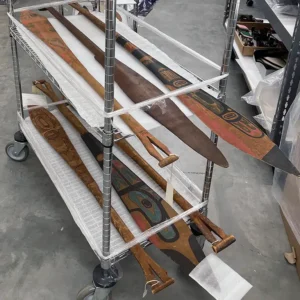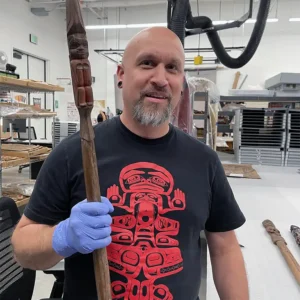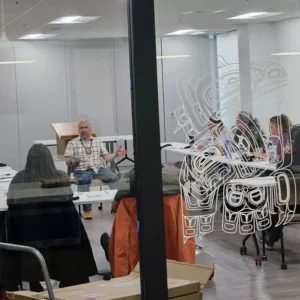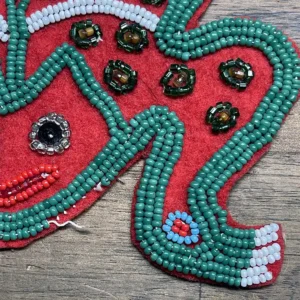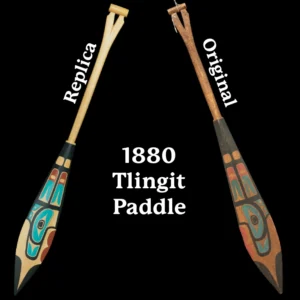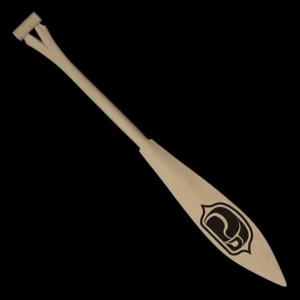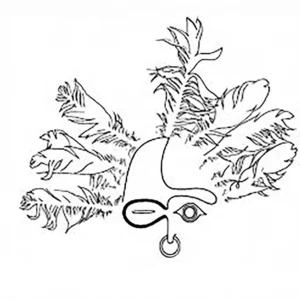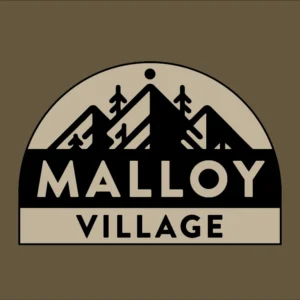Your cart is currently empty!
Community
Community — Overview
Welcome to my Community Involvement page. Here, you’ll discover how I engage with and contribute to my community through Tlingit cultural research, instruction, repatriation efforts, and civic duties.
I believe that art and community are deeply interconnected. Through my involvement in various projects and organizations, I strive to preserve and promote Tlingit culture, support education, and build understanding between different communities.
Is there a community project, organization, or event I should be aware of? Let me know. Just send me a message using the contact page form.
Bill Holm Center 2022 — Overview
In 2022, I was honored to receive the Connections to Culture Visiting Researcher Grant from the Bill Holm Center. This grant allowed me to focus my research on the museum’s collection of Tlingit paddles.

I completed this project in the summer of 2022, carefully documenting the craftsmanship and design of historical Tlingit paddles. I spent hours examining each paddle, noting the subtle variations in form, decoration, and construction techniques.
One of the highlights of this project was creating a replica of an 1880 Tlingit paddle. I based this replica on my research and donated it to the Burke Museum. It’s now used as a hands-on educational tool, allowing students to physically engage with a piece of Tlingit history and craftsmanship.
I’m currently using the data I gathered to create templates for other Tlingit artists who want to craft paddles in the traditional style. My hope is that this will help ensure that the specific techniques and designs of Tlingit paddle-making are preserved and passed on to future generations.
Bill Holm Center 2023 — Overview
In May 2023, I had the opportunity to conduct research at the Bill Holm Center at the Burke Museum. This time, my focus was on Tlingit Formline decorated objects from precontact through the early 20th century.
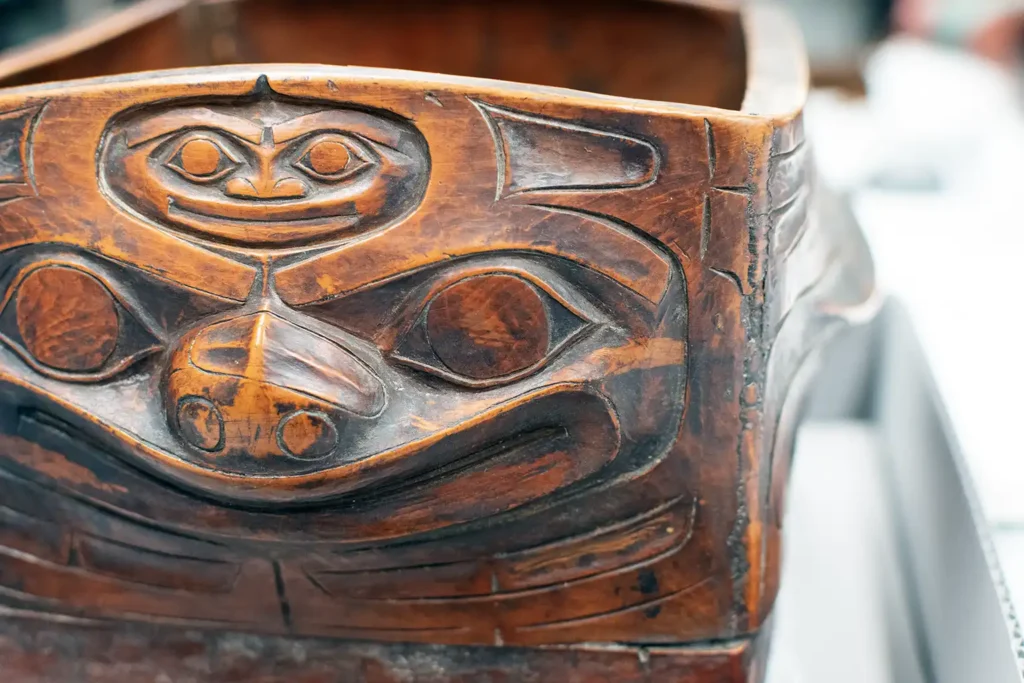
During my visit, I examined a wide range of Tlingit objects, gaining valuable insights into how Formline design evolved over time. This study included looking at what we often call “The Ancestors’ Work” – pieces from precontact times to the early 1900s.
For me, this research is more than just academic study – it’s a way to connect with my heritage and ensure that traditional Tlingit design techniques are preserved and understood. The knowledge I’ve gained directly informs my own artistic practice, allowing me to create works deeply rooted in Tlingit tradition while speaking to contemporary audiences.
I’m excited to use the findings from this research in my future classes and workshops. I hope it will help both Native and non-Native individuals appreciate the intricacies and significance of Tlingit Formline design.
Teaching Formline Design — Overview
Sharing my knowledge of Tlingit Formline design through workshops and classes is one of the ways I work to preserve and promote this traditional art form.
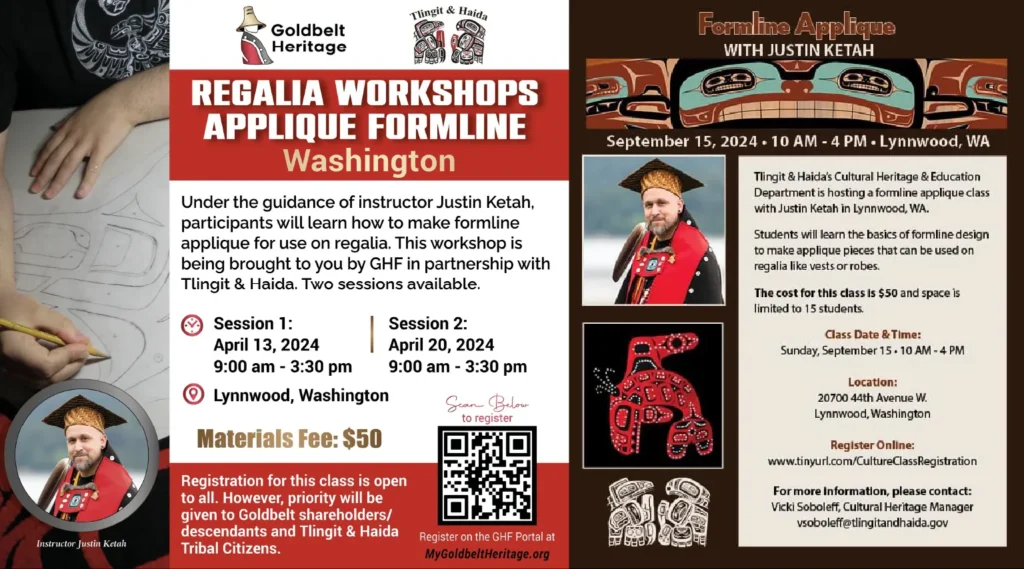
These instructional sessions are more than just art classes to me – they’re a means of cultural transmission, ensuring that the rich tradition of Tlingit visual art continues to thrive.
When I teach Formline design, I draw from both traditional knowledge and contemporary practice. My approach is informed by my research at institutions like the Bill Holm Center, as well as my own experiences as an artist. I aim to give my students a comprehensive understanding of Formline principles.
In my classes, we cover various aspects of Formline design, including:
- The basic elements of Formline (ovoids, U-forms, S-forms, etc.)
- The cultural significance of different designs and motifs
- Traditional and contemporary applications of Formline design
- Techniques for creating balanced and harmonious compositions
My students come from all walks of life – from Tlingit individuals wanting to connect with aspects of their culture to non-Native people interested in learning about Northwest Coast art. By teaching these classes, I hope not only to ensure the continuity of Tlingit artistic traditions but also to promote cross-cultural understanding and appreciation.
As of Summer 2025, I am now an adjunct professor at Northwest Indian College instructing on Formline Visual Design language.
Kiks.ádi Repatriation — Overview
Recently, I’ve had the privilege of being involved in efforts to repatriate Kiks.ádi clan artifacts. This work is about contributing to the return of culturally significant items to their rightful communities.

Repatriation – the process of returning cultural artifacts to their original communities – is crucial for cultural healing and preservation for many Indigenous peoples. I’ve been actively involved in a specific repatriation effort for the Kiks.ádi clan, one of the principal clans of the Tlingit people.
I recently had the opportunity to facilitate the repatriation of two significant Kiks.ádi clan items: a beaded headband and a frog patch. Through careful research and collaboration with various institutions and individuals, including the Sheldon Jackson Museum and Tribal members, I was able to identify the rightful owner of these items.
The journey culminated in the successful return of the artifacts to Ray Wilson, Kiks.ádi clan leader from Gagaan Hít (Sun House). This repatriation was particularly meaningful as the items were created by Ray Wilson’s grandmother, Annie Michael.
This experience has inspired me to further educate myself on NAGPRA (Native American Graves Protection and Repatriation Act) and repatriation processes. I intend to build upon what I learned from this project to help advocate for and be involved in future repatriation efforts.
T’laneq Fundraiser — Overview
I’m proud to be a supporter of the annual T’laneq’ Gathering for a Celebration, a crucial fundraising event for the Northwest Indian College Foundation (NWICF).
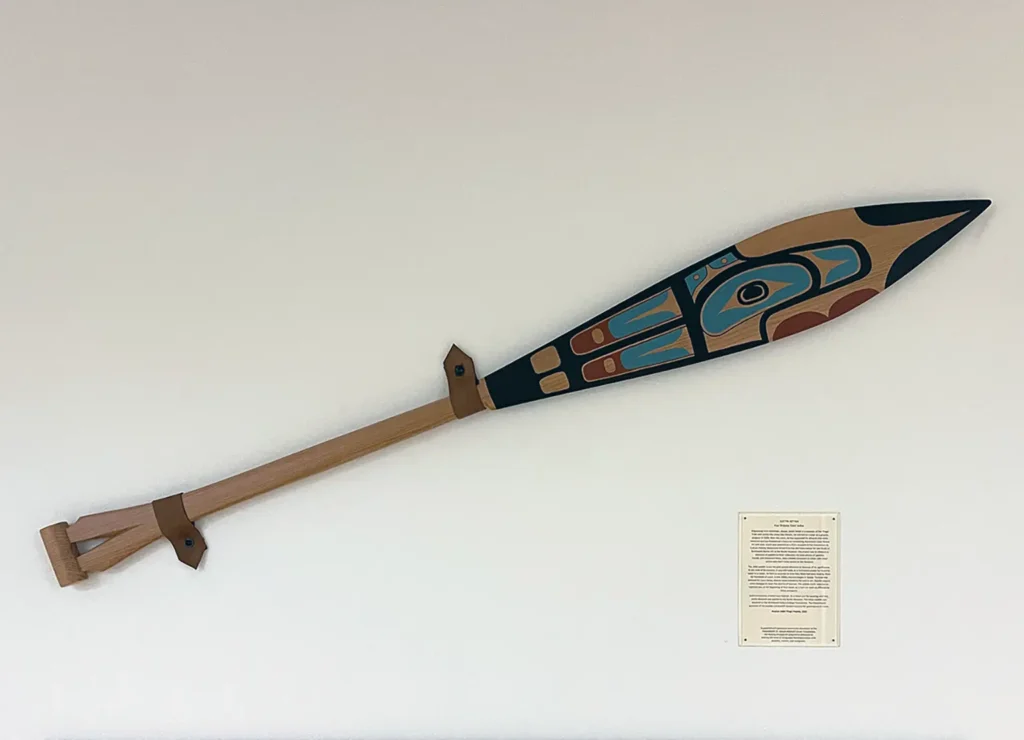
The T’laneq’ Gathering is organized by the Northwest Indian College (NWIC) and its Foundation (NWICF). This event plays a vital role in generating scholarships and support for students attending the seven NWIC campuses – the only Tribal college serving Native Americans in Washington, Oregon, and Idaho.
I’ve been able to contribute to this event in several ways:
In 2022, I donated a replica of an 1880 Tlingit paddle, based on my research at the Burke Museum. This piece was part of the event’s fundraising efforts, helping to generate support for NWIC students.
I’ve had the opportunity to speak as a student, sharing my experiences as a Native artist and NWIC alumnus. It’s my hope that by doing this, I can inspire current students and demonstrate the impact of the education and support provided by NWIC.
Through my participation, I help showcase the rich artistic traditions of Northwest Coast Native peoples, contributing to the event’s celebration of Indigenous culture and heritage.
The T’laneq’ Gathering embodies the Lummi value of “Lengesot” – taking care of ourselves, watching out for ourselves, and loving and caring for one another. By supporting this event, I feel I’m contributing to a community-wide effort to empower Tribal nations through education.
Click here to read more about Tl’aneq’ 2022
Your contribution to the foundation is greatly appreciated. Click here to reach the donation page.
FCS Fundraiser — Overview
I’ve had the opportunity to contribute to fundraising efforts for Ferndale Community Services, supporting local community support programs through my art.
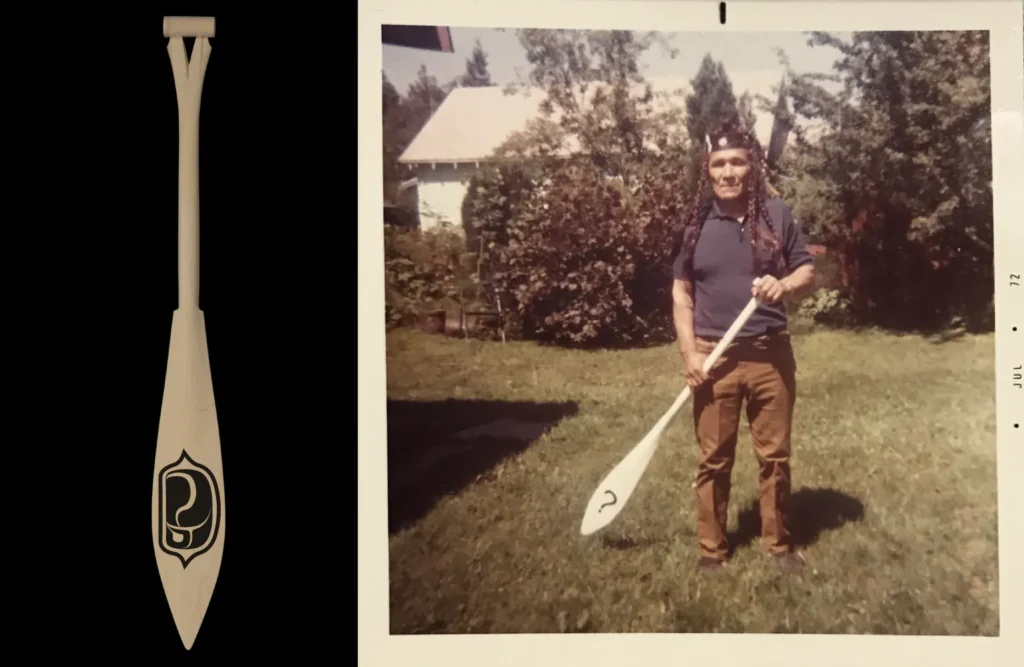
Ferndale Community Services (FCS) is an important organization in our community, providing essential support services to local residents in need. When I learned about their work, I wanted to find a way to support their efforts through my art.
For the FCS fundraiser, I donated a paddle decorated with my signature questioning eye logo. I chose this design specifically because it resonates with the mission of FCS. The questioning eye logo came from my understanding of the value of community connection, which aligns perfectly with what FCS does.
Contributing to this fundraiser was a way for me to give back to my community and use my art as a force for positive change. It also showed me how contemporary Native art can play a meaningful role in community support efforts.
Through this contribution, I was able to help raise funds for important local services while also strengthening the connections between Ferndale’s Native and non-Native communities. It’s experiences like these that remind me of the power of art to bring people together and make a difference in our local community.
By the way, the image above is my grandfather. This is my inspiration for this paddle, and the questioning eye design.
Friends of SJ Museum — Overview
I serve on the board of the Friends of Sheldon Jackson Museum, where I work to address historical injustices while supporting the preservation and promotion of Alaska Native art and culture.
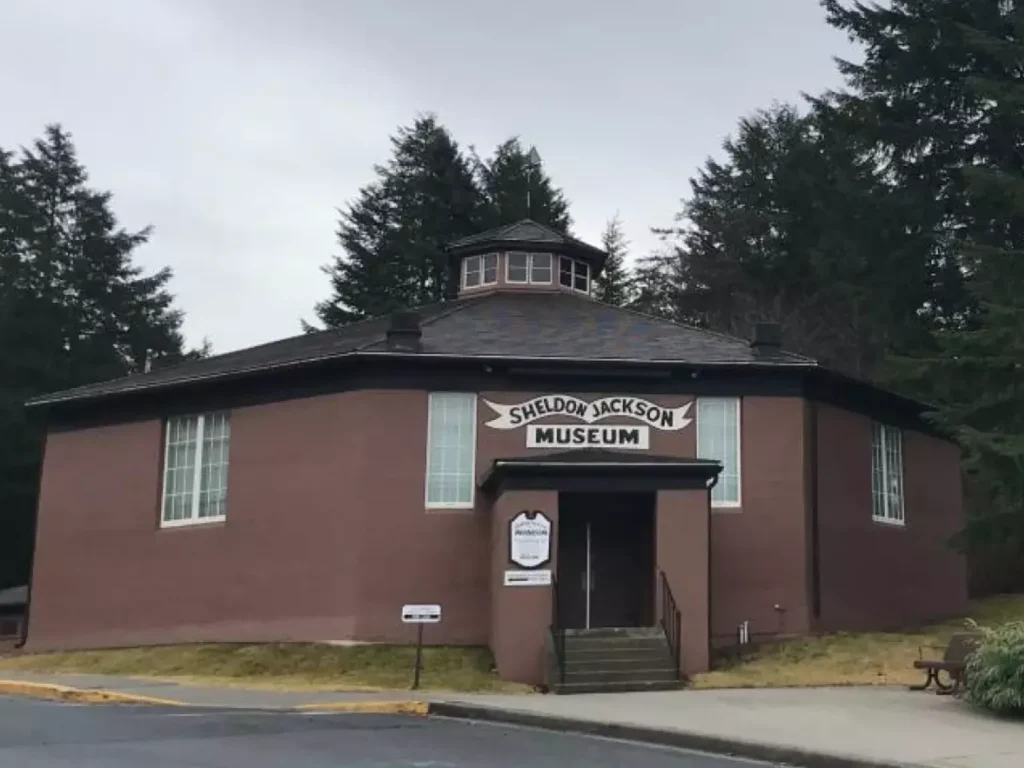
The Sheldon Jackson Museum, located in Sitka, Alaska, houses an impressive collection of Alaska Native artifacts and art. However, the museum faces a fundamental contradiction: while its programming is 98% Indigenous-led, its foundational narrative honors Sheldon Jackson, a missionary who was a central agent of settler colonialism and a founder of the Alaskan boarding school system that inflicted deep trauma on Indigenous communities.
As a board member of the Friends of Sheldon Jackson Museum (FoSJM) since September 2023, I joined specifically to be a Native voice for change in addressing this painful legacy. The museum’s introductory story, presented at the very entrance, has historically celebrated Jackson while excluding the painful truth of his role in forced assimilation and the fact that the museum sits on the traditional homeland of the Tlingit people.
Through my work with the International Coalition of Sites of Conscience program “Addressing the Silences,” I’ve collaborated with the Sitka Tribe of Alaska to transform how the museum tells its story. This partnership focuses on:
- Transforming the museum’s name and entrance story to acknowledge the full, complex truth of its history
- Centering Indigenous voices and perspectives from the moment visitors enter
- Building ongoing trust and repair between the museum and local Native communities
- Creating internal changes including establishing a tribal liaison position (which I serve in)
- Updating exhibition terminology to respect Tlingit language preferences
My specific goals in this role include:
- Advocating for proper representation of Sheldon Jackson’s place in history, including full acknowledgment of his harmful legacy
- Promoting discussions about changing the name of the museum to better reflect its mission and respect for Native communities
- Building stronger, more meaningful connections between the museum and local Native communities
- Guiding the future of the Alaska Native Artist Residency Program (NARP) to provide more accessible education, including online options
This work represents more than just museum reform—it’s about confronting the foundational contradictions that many cultural institutions face and creating space for Indigenous voices to lead the narrative about their own cultures and histories.
Through my work with FoSJM, I hope to ensure that Alaska Native artistic traditions are not only preserved and shared, but that they’re presented within truthful, respectful contexts that acknowledge both beauty and pain in our shared history.
Ferndale Arts Commission — Overview
As Vice-Chair of the Ferndale Arts Commission, I have the opportunity to help shape the artistic landscape of Ferndale, promoting public art and cultural initiatives.
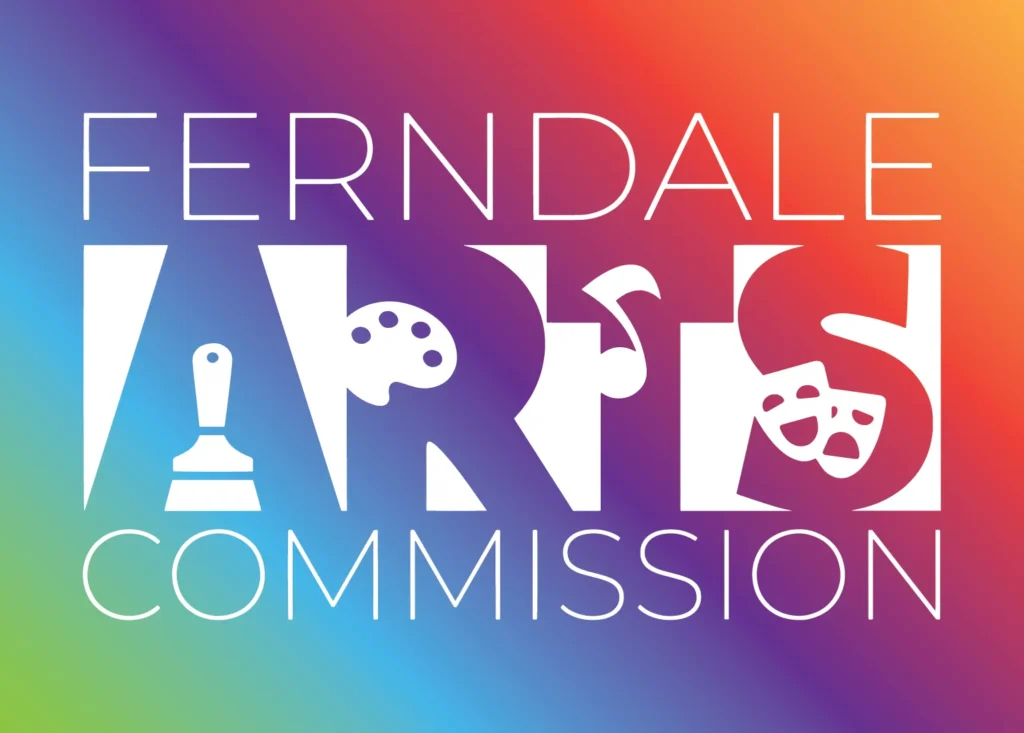
The Ferndale Arts Commission plays a crucial role in enhancing the cultural life of our city through public art initiatives, cultural events, and community engagement. As Vice-Chair of the commission, I bring my perspective as a Tlingit artist to this important work.
In my role on the Ferndale Arts Commission, I contribute in several ways:
I help evaluate and select public art projects for the city, working to ensure a diverse and representative range of artistic expressions.
I provide insights on Indigenous art and culture, helping to ensure that Native voices are represented in Ferndale’s public art landscape.
I assist in organizing community events and workshops that engage Ferndale residents with the arts.
As Vice-Chair, I’m involved in shaping policies that support and promote the arts in Ferndale.
One of the projects I’m particularly proud of is the Downtown Mural Project, which includes my own mural “Ancestral Spirits” at Kevin’s Car Wash. This project is a great example of how my roles as an artist and commission member intersect to bring Native art into public spaces.
Through my work on the Ferndale Arts Commission, I hope to help create a more inclusive and culturally rich community. It’s important to me that Indigenous perspectives are considered in our city’s artistic development, fostering a sense of representation and cultural awareness among Ferndale residents. I have served this board since September 2022.
Malloy Village HOA — Overview
While it might seem different from my other community roles, serving on the Malloy Village Homeowners Association Board since January 2022 is another way I work to build a strong, inclusive community right here in my Ferndale neighborhood.
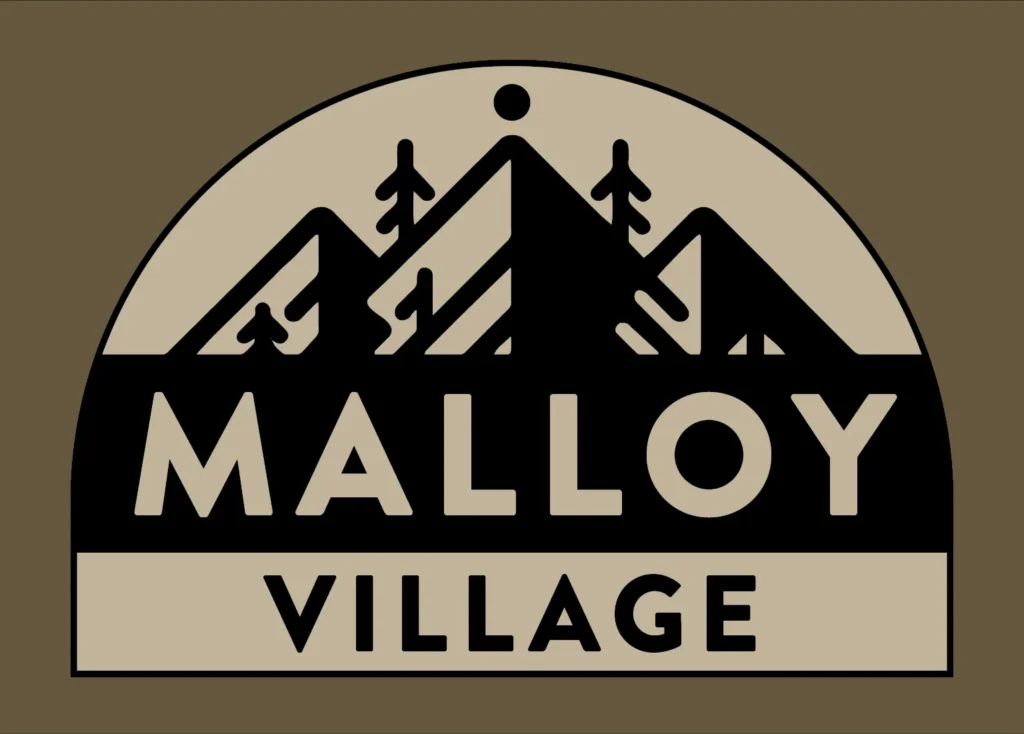
You might wonder how being on an HOA board connects to my work as a Tlingit artist and cultural advocate. For me, it’s all about community building, just on a more local, day-to-day level. In this role, I have the opportunity to bring the values of respect, collaboration, and inclusivity that are so important in Tlingit culture into my immediate neighborhood.
During my time as Chair (2022-2024), I worked to bring Tlingit values of respect, collaboration, and inclusivity into my immediate community. This leadership role allowed me to:
- Lead board meetings and facilitate community decision-making processes
- Oversee the management of shared spaces and resources
- Work to resolve conflicts and build consensus among neighbors
- Organize community events that brought residents together
One of the most meaningful aspects of this role was introducing cultural awareness into HOA activities, including implementing land acknowledgments at meetings and incorporating more inclusive practices in community events.
My tenure as HOA Chair taught me valuable lessons about grassroots community leadership – its challenges, rewards, and limitations. The experience provided important insights that continue to inform my other community work.
Starting in 2025, I’ve transitioned from Chair to Secretary. In this role, I can focus more on building the team, supporting the new chair, and strengthening the administrative structure of the board. This shift allows me to maintain my connection with my immediate community while balancing my other artistic and cultural commitments.
The time spent in neighborhood leadership has deepened my understanding of the day-to-day realities of community life and the different ways people engage with their immediate environment. These perspectives have made me a more effective advocate in my arts-related positions.
This ongoing experience is part of my journey to build strong, respectful, and inclusive communities wherever I find myself.

